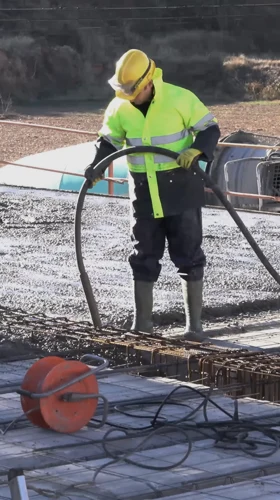How does ambient temperature affect the concrete vibration process?
Ambient temperature is a crucial factor that directly influences the workability of concrete and, therefore, the effectiveness of the vibration process. We recommend paying special attention to the following conditions:
- High temperatures: Heat accelerates the setting process of concrete, significantly reducing the time available for proper placement and vibration. Rapid water loss can result in a less workable mix and increase the risk of plastic shrinkage cracks. Under these conditions, it is vital to vibrate quickly and efficiently after pouring. The power and reliability of ENAR equipment are key allies, allowing effective compaction in less time, before the concrete loses its workability.
- Low temperatures: Cold, on the other hand, delays setting. Although this allows more time for vibration, if the temperature drops close to 0°C, the water in the mix can freeze, expand and cause irreparable internal damage to the concrete structure. Proper vibration is essential to remove as much air as possible and improve the concrete's resistance to freeze-thaw cycles.
Thanks to certain additives included in the formulations, the products can be used in extreme temperature conditions: they work correctly below 0°C without risk of freezing, and also allow setting to be delayed when working in hot environments.
View more articles: Concrete vibration process
- What is concrete vibration and why is it important?
- What are the differences between internal and external concrete vibrators?
- How is a concrete vibrator used correctly?
- What safety precautions should be taken when using concrete vibrators?
- How long should concrete be vibrated in different construction situations?
- What features set ENAR´s concrete vibrators apart from other manufacturers?
- What factors should I consider when choosing the right concrete vibrator for my project?
- What are the differences between internal and external concrete vibrators?
- What equipment is required for the concrete vibration process?
- How to maintain concrete vibrators in good condition?


